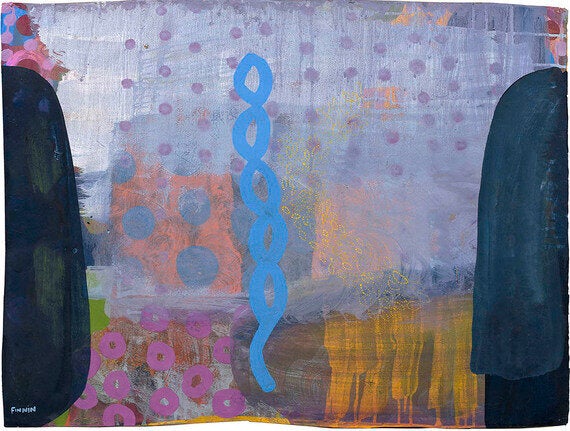Martin Finnin current exhibition, titled: Renegade Amongst the Dusty Nouns, at the John Martin Gallery in Mayfair skilfully recreates an abstract world that consists of figures, movement and memories. Finnin finds inspiration in his homeland, Ireland, and his trips to India and Italy. His paintings are intelligent, exceptionally well-executed and full of symbols that always tell a story to be discovered by the viewer.

Sugar and the Outside World by Martin Finnin
As Laura Campbell, the curator, explains:
"Finnin cleverly depicts the elements of the world, predominantly inspired by the landscapes, buildings and the people whilst remaining distant in some way from a commitment to any one element in particular. There is an effortless portrayal of movement and energy from the paintings, the eye travels consecutively from one shape to another, weaving around and in between what could be a person, a garden fence, a segment of paving or quite simply a reference to a piece of sporting equipment. My favourite piece in this exhibition is in fact an example of Martin's works on paper, 'Sugar and the Outside World'. The fine lines and dissolving colours are a montage of Martin's journeys. They are warm, inviting and each time you revisit them to look you see something new".
Finnin kindly agreed to respond to the following questions:
1. Where do you get the inspiration from? How is the process of making a painting?
"Inspiration is a funny thing. It seems to enter you from the outside but really comes from within. It is not static. It is the flow of perceptions taken in mostly subconsciously which becomes part of you and mixes with all of you to come back out, sometimes recognisable but mostly new, evolved, expanded. Painting for me is a long process of putting stuff on and wiping it off. I am always working on many pieces simultaneously with each piece taking months to years to complete. I might work on a piece for weeks and then have to abandon it, turning it in to the wall for the same amount of time. As I go through this process of working and waiting, of adding and washing it off again, the images and shapes in my head sort themselves out and it's lovely to see when some of them decide to appear in the paintings".
2. The paintings inspired by Ireland are very different to the ones inspired by India. Can you please expand on that? What do you think are the main differences and similarities?
"Quite a few of the works on paper in the show e.g. Long Winded Bullet Point (India) and A Wet Wonder Waiting are more obviously inspired by India as these are some of the actual works that travelled there with me. They have a very Indian feel because that environment has physically shaped them. The pigments were from the local market, the washes dried instantly in the intense heat and I needed to paint more acutely to dissipate the sensory overload that comes with being there. I love that Indian overload! There is no doubt that the different, often subdued (some might say grey) light we have in Ireland defines my perception of the environment I spend most of my time in and thus influences my work. The light we have in Ireland might be less intense but it is very dramatic. Colours are intensely highlighted against their background. A bit like a stone meeting an orange".
3. The paintings are full of symbols. What do they mean?
"To be honest I don't know what they mean or if in fact they have a particular meaning at all. The symbols come from various sources. Sometimes they are shapes that appear through continuous drawing and looking at books or around me. Occasionally they can be as simple as the pure joy of an intuitive hand movement. Some shapes may eventually evolve to become symbolic. It still surprises me how much time passes before an images I see in my surroundings transmits to a painting. It takes even longer for me to attempt to cognitively link these symbols back to their source. Even then their meaning seems more of a sensation, something that sits between words".
4. Why should someone come to your show?
"Because I think people enjoy an excuse to step out of the stream of time, do something different for a while, disconnect. A bit of visual grazing on colours, layers and textures that might allow you to side-step the insistent mind for an instant and expand in that space that the painting helped you to create. The first ten of you to come and say you have found the show via this article in the Huffington Post will receive a catalogue with a drawing on it signed by me, Martin Finnin..."